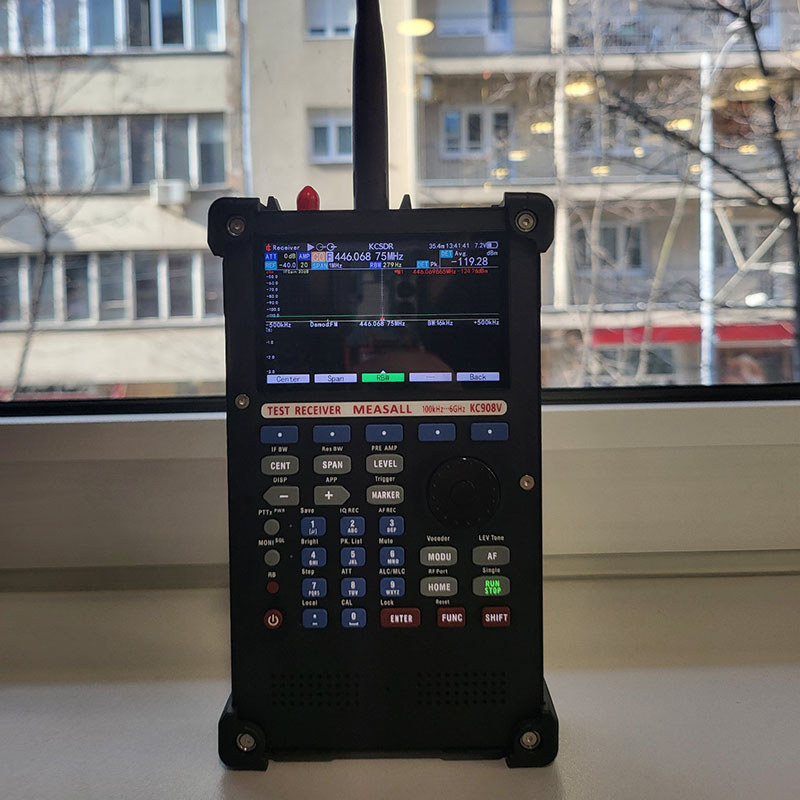Theory
Utilizing a method combining superheterodyne and zero IF, signals are processed by shifting frequencies with mixing and employing a zero IF transceiver.
- Zero IF Method: Signals undergo mixing with a local oscillator (LO) to achieve zero intermediate frequency (IF), facilitating efficient processing.
- Signal Processing: Mixing generates baseband signals by combining positive and negative frequency components, with IQ signals enabling precise distinction between them.
- Spectrum Analysis: Digital IQ signals are analyzed via Fast Fourier Transform (FFT), revealing frequency components around DC with positive and negative frequencies distributed accordingly. Effective real-time bandwidth is capped at 15MHz, with wider sweeps achieved through scanning and splicing.
- Pre-Selectors and Filters: Front-end pre-selectors prevent receiver overload and enhance anti-interference capabilities, albeit with limited filtering due to size constraints.
- Transmitter Function: Signal transmission reverses the receiver process, converting digital IQ signals to analog baseband signals for modulation with an upconverter.
- Digital Signal Processing: FPGA and MCU handle demodulation, with USB3.0 enabling wider bandwidth transmission for third-party software processing.
- Spectrum Display: Display differs from conventional spectrometers, showing peak or average values without sweeping “illusion,” necessitating adjustments in analysis techniques.
- Frequency Resolution: Display limitations exist due to pixel count, addressed by displaying peak values of multiple frequencies per pixel.
This concise overview sheds light on the intricacies of signal processing and spectrum analysis, offering insights for effective utilization.

Applications of RF Spectrum Analyzers
Wireless Communication Testing: RF spectrum analyzers are essential tools for testing and analyzing wireless communication systems, including Wi-Fi, Bluetooth, cellular networks, and more. They help in optimizing signal quality, identifying interference, and troubleshooting connectivity issues.
RF Signal Monitoring: Spectrum analyzers are used for real-time monitoring of RF signals in various environments, such as broadcast stations, public safety communications, and industrial facilities. They detect signal abnormalities, unauthorized transmissions, and ensure regulatory compliance.
Radar and Satellite Communication: RF spectrum analyzers play a crucial role in radar and satellite communication systems by analyzing signal characteristics, detecting interference, and optimizing performance. They aid in radar system design, satellite link analysis, and interference mitigation.
Electronic Warfare and Signal Intelligence: Military and defense applications utilize spectrum analyzers for electronic warfare (EW) and signal intelligence (SIGINT) operations. They identify and analyze enemy signals, detect jamming attempts, and support spectrum management in battlefield scenarios.

RF Component Testing: Spectrum analyzers are used in laboratories and manufacturing facilities for testing RF components such as amplifiers, filters, antennas, and oscillators. They measure signal parameters, analyze frequency response, and validate performance specifications.
Wireless Network Optimization: RF spectrum analyzers assist network engineers and administrators in optimizing wireless networks for performance and reliability. They identify signal coverage gaps, assess channel utilization, and diagnose interference sources to enhance network efficiency.
EMI/EMC Compliance Testing: In electromagnetic compatibility (EMC) testing, spectrum analyzers are employed to measure electromagnetic interference (EMI) emissions and assess compliance with regulatory standards. They identify problematic frequencies, quantify emissions levels, and aid in troubleshooting EMC issues.
Radio Frequency Identification (RFID) Systems: Spectrum analyzers are used in RFID system deployment and maintenance to analyze tag communication, assess signal strength, and troubleshoot read-range limitations. They ensure reliable operation of RFID technology in various applications, including inventory management and asset tracking.
Satellite and Radio Astronomy: In scientific research, spectrum analyzers are utilized in satellite communication systems and radio astronomy observatories to analyze celestial signals, study cosmic phenomena, and map radio frequency spectra. They contribute to advancements in astronomy, astrophysics, and space exploration.
Environmental Monitoring and Surveillance: RF spectrum analyzers are employed in environmental monitoring and surveillance applications to detect and analyze RF emissions from sources such as industrial equipment, power lines, and electronic devices. They assist in assessing environmental impact, investigating pollution sources, and enforcing regulatory compliance.


Review from Christoph / HB9DTZ:
The KC908 is a very compact and lightweight spectrum analyzer / measuring receiver. Compared with other professional devices it’s less than half of the size and 1/3 of the weight. The developpers implemented a lot of very usable features for radio monitoring tasks. Obviously those guys have a very good knowledge of the radio monitoring specific needs.
– The level-tone for radio direction finding is very accurate and shows even small changes in signal strength without looking at the display. There are no steps in the tone frequency, tone changes are following very smoothly the signal level.
– The spectrogram has a selectable time per line. This will allow the user to analyze modulation waveforms with a fast spectrogram and also long-term analysis of duty-cycle with a slow spectrogram.
– The marker demodulation feature allows a quick access to active frequencies. (The user has to pre-select the demodulation type, there is no automatic detection of the modulation type.)
– The peak signal table with automatic percentage of activity calculation is a very nice feature for channel occupancy tests!
– The marker-autopeak feature in combination with the marker-demodulation will give the user an extremely fast scanning receiver with automatic demodulation of the strongest signal. The parameters are adjustable to fit the user’s needs.
– The device is housed in a robust milled aluminium case with rubber bumpers. But the user has to take care about the connectors. They are very precise and compared to a N-connector not that robust. -> take care!
– The battery lifetime is more than enough for prolonged outdoor operation. The manufacturer ships the analyzer with good quality 18650 cells already installed. Battery operation is suggested in interference hunting tasks because the DC-DC convertors for external power (USB-C and DC) creates some additional noise. (This is normal behaviour)
– The display layout is very logical from my point of view. All status indicators stay at the same place, so it’s easy to check all parameters at a glance. The display resolution is excellent and especially in the spectrogram view, very small signal changes are clearly visible.
– The availability of the digital voice demodulation hardware is a game changer. There is no other portable device on the market with all DV modes implemented. (some older AOR receivers can do DV as well, but they have a noticeable worse performance in decoding low level signals)
– The user manual is very detailled and explains a lot of background information. Great for beginners! But the manual should be updated with all features of the recent firmware… e.g.
Overall the developpers have done a great job. The KC908 is an impressive tool. I like it!
Beside of all this positive feedback, here are few things that could / should be improved:
– Even if the display is a bright, high quality transflective type, the visibility in direct sunlight is not good enough / poor. This is because of the dark color scheme. A bright (inverted) color scheme would create an excellent readability in sunlight condition and would extremely increase the usability in outdoor scenarios. This could be done with a firmware upgrade. I hope, that the developpers could add that soon. This is my priority one change request and the only reason to rate the device with only 4 stars!
– In spectrum mode, the analyzer doesn’t offer a spectrogram viev. This is because of “stitching” the 15MHz segments together and there is a risk for level steps. Anyway, the availability of a spectrogram view would massively increase the probability of sporadic signal detection in wide-band monitoring scenarios. As a workaround I’m using the max-hold function but a spectrogram would be the better coice.
– The analyzer offers 999 memory channels, each with a full parameter set and an alphanumeric description. Today, all the programming of the memory channels has to be done manually via the device keypad and encoder. This is not convenient for programming a lot of channels or programming multiple devices. There is also no possibility for backup the progrtammed data. Hopefully the developpers will implement a programming option via USB interface or via SD card at a later time. Programming so many channels via keypad and encoder will also wear-out the man-machine interface of the KC908.
The device gets quite hot after > 15 min. runtime. This is a normal behaviour for such a small and powerful device. But there is a risk of “low temperature burns” for the user. Since the boot time takes only few seconds, I switched off the analyzer between measuring tasks as a workaround.
Best regards: Christoph / HB9DTZ
